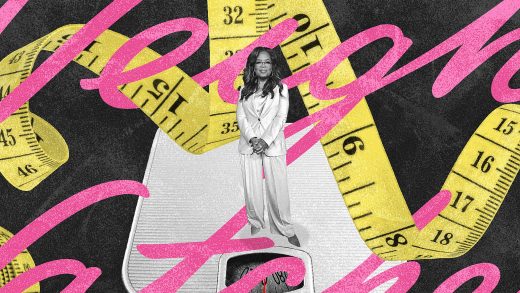Oprah takes on toxic diet culture during her last appearance with WeightWatchers
Oprah takes on toxic diet culture during her last appearance with WeightWatchers before leaving board
As she steps down from WeightWatchers board and sells her shares, the company’s chief dieter examines the culture she helped create.
BY Yasmin Gagne
Oprah Winfrey wants people to love their bodies. She wants people to know that sometimes dieting doesn’t work, but also sometimes it does. She wants viewers who logged into her three-hour, live-streamed event on Thursday night with WeightWatchers—a company that, until this month, she owned 15% of—to know that she was lied to. She wants them to understand that, for years, she sold them that lie: that willpower is all you need to lose weight. But she also wants it known that it wasn’t really her fault.
She wants people to know that sometimes you might need a GLP-1 medication—like Ozempic or Wegovy—to help you on your weight “health” journey.
“I want to acknowledge that I have been a steadfast participant in diet culture through my platforms, through the magazine, through the talk show for 25 years. I’ve been a major contributor to it. I set a standard for people watching that neither I nor anybody else could uphold,” Winfrey explained. “Maya Angelou said, ‘When you know better, you do better.’ These conversations for me are an effort to do better.”
Thursday’s event, titled “Making The Shift: A New Way to Think About Weight,” was Winfrey’s last appearance before she leaves the WeightWatchers board. Winfrey shared the stage with a handful of celebrities and influencers—including actor Busy Philipps, comedian Rebel Wilson, and IT Cosmetics founder Jamie Kern Lima—who spoke about their own relationships with their bodies (but didn’t divulge whether they take medication). The point of the event, according to a workbook that WeightWatchers placed on attendees’ seats, was “to welcome you back to the conversation your body has been having with you since you were born.”
The event was the latest reminder of Winfrey’s yo-yo relationship with diet culture—and WeightWatchers itself—over the past several months. After photos emerged last fall of her suddenly svelte figure, rumors that Winfrey was taking weight-loss medication began swirling. She acknowledged taking the drugs in a People cover story in December. And then, in February, announced that she was stepping down from the WeightWatchers board, effective this month. (WeightWatchers’s stock dropped 25% the day the news broke.) She produced an ABC special on weight-loss medication in March. In a statement WeightWatchers says she is not leaving the company entirely, “Oprah’s current contract with WeightWatchers continues through the company’s 2025 annual meeting or May 31, 2025, whichever comes earlier. Though she is not standing for reelection on the board, she will continue to advise and collaborate with WeightWatchers.”
Winfrey’s moves reflect a broader cultural shift. The arrival and increasing availability of GLP-1 medication, such as Wegovy and Zepbound, which inhibit hunger and help users shed pounds, has transformed the way people think about weight loss—and the way they view WeightWatchers. The company, after all, led the conversation around weight loss for more than six decades. Today, it’s reckoning with being seen as either complicit in toxic diet culture or, perhaps worse, irrelevant, a relic of a time before medication changed everything.
A shift, to what?
Winfrey started the evening by leading a conversation between WeightWatchers CEO Sima Sistani and body-acceptance activist and Megababe founder Katie Sturino. The two had been part of a viral Instagram moment a few months earlier, after Sturino took to social media to call out WeightWatchers for making people, including herself, feel ashamed of their bodies. Sistani, in a branding coup, responded by posting an apology video to Sturino, acknowledging the unrealistic standards and stigma her company had perpetuated. The apology video took off: When Sturino posted it on her account, it received 42,000 likes.
On Thursday, Sistani used her time on stage to revisit many of the same points that she made in the video. But she also pointed out that she herself had lost and kept off 60 pounds through WeightWatchers’s traditional points and group counseling method. It was her way of highlighting the company’s “two truths,” as she called them.
“On our walls, it said, ‘It’s choice, not chance.’ That’s wrong,” Sistani said on stage. “We took that down from the walls. We needed to . . . have a hard conversation and say, this program that we all can acknowledge has helped millions of people, is [also] a program that failed many people who walked away feeling that it was their moral failing, that it was their fault.”
Even before GLP-1s began to eat its lunch, WeightWatchers was struggling to maintain its relevance. Faced with the growth of the body positivity movement, the company briefly renamed itself Wellness that Works in 2018, couching its methods in fuzzy health and wellness language. Four years later, the company went back to WeightWatchers and leaned into its digital offerings to compete with upstart weight-loss apps, like Noom. Meanwhile, it’s been shedding subscribers. In 2018, the company had 4.6 million subscribers; it expects to end this year with 3.8 million people on the platform.
WeightWatchers’s net losses in 2022 were $256 million, with revenue down 18.8% year-over-year. Sistani, who took over as CEO from social network Houseparty in March 2022, has slowed the losses—somewhat. Revenue was down 14.5% in 2023, compared to the year prior, with a net loss of $112 million. But investors don’t seem confident that the company will have a solid footing as the wave of weight-loss medications starts rushing in. Its stock has dropped by 70% since the start of the year.
A year ago, WeightWatchers acquired the telehealth obesity drug provider, Sequence, for $132 million. Sistani sees the platform, which now operates as WeightWatchers Clinic, and its 67,000 subscribers, as the future: a way to blend healthcare with her company’s traditional behavioral approach to weight care.
How to communicate this dual approach to customers, without making them feel either guilty or betrayed, is another matter. “We need to make sure that people know that it’s your choice, it’s your journey,” Sistani said on Thursday. Rather than offering one rigid method, WeightWatchers now offers a buffet of solutions for people on their weight health journey.
Sturino, for her part, was clear about what she wants to offer on such journeys. When Winfrey pressed her to explain why a body-positivity advocate would appear at an event hosted by WeightWatchers, Sturino was firm: “If we don’t have this conversation, if we don’t insert our voice into the conversation, someone else will. Someone else will make those decisions for us again.” The implication was clear: WeightWatchers is no longer in charge of the narrative around weight loss.
The Oprah Winfrey show
Throughout the event, Winfrey returned again and again to her mortifying 1985 interview with comedian Joan Rivers, who wagged her finger in Winfrey’s face and told her to lose weight. Winfrey also recalled the now infamous “wagon of fat” episode of her talk show, where she wheeled in 67 pounds of animal fat to represent the amount of weight she had lost (which she subsequently regained).
By orienting the conversation around her personal journey, and her own use of GLP-1s for weight loss, Winfrey tried to both anticipate and deflect criticism of her flipflop. She propagated diet culture, sure. But she was also a victim of it. She made a lot of money from it—but she’s planning to donate the profits from selling her WeightWatchers shares to the National Museum of African American History and Culture.
Winfrey also seemed to defend herself from critics who see her new embrace of GLP-1s as yet another spokesperson-like role. Her ABC special featured Amanda Velazquez, director of obesity medicine at Cedars-Sinai and Dr. W. Scott Butsch, director of obesity medicine within the Cleveland Clinic’s Bariatric and Metabolic Institute. Both doctors have received money from GLP-1 pharma giants Novo Nordisk and Eli Lilly.
“I know some people said it felt like an infomercial for weight loss drugs,” Winfrey acknowledged. “But the reason I wanted to do that show is because something clicked for me when I was told obesity is a disease.”
But amid Winfrey’s I’m just like you admissions about loving bread and wearing Spanx, the star barely touched on the fact that, unlike many in the audience, that she can afford weight-loss medication. Indeed, writer Tressie McMillan Cottom, who wrote about the ABC special for the New York Times, was one of the few speakers to bring up the cost of these drugs.
WeightWatcher’s GLP-1 plan, administered by WeightWatchers Clinic, currently costs $99 a month in addition to the cost of the drugs, which come in at more than $1,000 a month without insurance, according to WeightWatchers’ own site. On the same page, the company acknowledges the high price of the drug, and the fact that it is only covered by some insurance plans under specific circumstances. (In her opening conversation, Sistani mentioned a desire to work with insurers to cover its GLP-1 offering, a potentially lucrative new business line for the company.)
Winfrey seemed less interested in wrestling with anything as pedestrian as the costs of these new, potentially life-changing medications. Several times during the event, she expressed a desire to “re-language to ourselves how remarkable we are.” The cryptic phrase seemed to reflect the muddiness of this cultural moment. When a slim figure is easier to obtain than ever before (if you have the cash), what does it mean to be overweight?
Sistani, perhaps, came closest to defining what weight loss culture might look like in the coming years, as she laid out her brand’s new direction. “There are still many people who need solutions. We provide nutritional advice. We provide healthy habits. We provide movement. We provide community. That is still a great need for people. There are also people who have a chronic condition who are going to need a medical team, who are going to need medication. We also provide that,” she said. “It’s like love it, lose it, maintain it. We’re here for it. We’re watching our weight for what it tells us about our health. That means a spectrum of solutions.” How the company plans to market that wide spectrum of solutions—while navigating all the complicated emotional and cultural baggage that comes with them—remains unclear.
At the end of the special, Winfrey gave Sistani the last word. Her comment, like much of the event, was both inspiring and vague. “It takes a collective effort to change a culture,” she said. “I want you all to participate in your life.”
ABOUT THE AUTHOR
(17)



